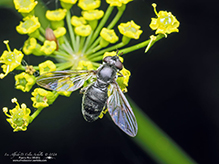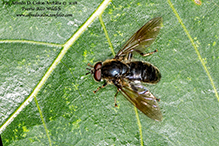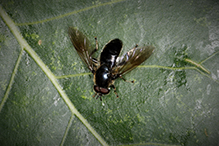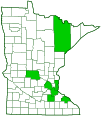pitheads
(Pipiza spp.)
Overview • Description • Distribution • Taxonomy
Description |
An important identification feature of “higher Diptera”, those in the suborder Brachycera, is the postpronotal lobes, which are lateral expansions of the shoulder (humeral) area of the pronotum. Hoverflies in the subfamily Syrphinae have no hairs on the postpronotal lobes. The back of the head is strongly concave and tightly appressed to the thorax. On the male the eyes meet at the top of the head. When viewed from above, the male has five visible abdominal segments. Hoverflies in the tribe Pipizini have hairy, evenly rounded faces. There are never unbroken yellow or other shining bands across the abdomen. Pitheads are small, black hoverflies. The face is flattened and it does not have small, rounded bumps (tubercles). It is as wide or wider below, at the sides of the mouth, than above, at the antennae. The antennae are shorter than the head. The abdomen is either all black, or it has a pair of yellow spots on tergite two, and sometimes also on tergite three. The wings are short and wide. On the hind leg, the third segment (femur) is slender and slightly enlarged at the tip (apex). |
Distribution |
||
|
Sources Telford, Horace S.. (1939). The Syrphidae of Minnesota. University of Minnesota. Minnesota Agricultural Experiment Station. |
|
| 11/14/2024 | ||
Taxonomy |
|
Order |
|
Suborder |
Brachycera |
Infraorder |
Cyclorrhapha |
Zoosection |
Aschiza |
Family |
Syrphidae (hover flies) |
Subfamily |
Pipizinae (pitheads and kin) |
The genus Pipiza was formerly place in the tribe Pipizini in the subfamily Syrphinae. In a recent genetic study (Mengual, 2015), the tribe Pipizini was elevated to the subfamily Pipizinae. Two subsequent studies corroborated the move. |
|
Subordinate Taxa |
|
ebony pithead (Pipiza atrata) four-spotted pithead (Pipiza quadrimaculata) large-legged pithead (Pipiza macrofemoralis) sumac gall pithead (Pipiza puella) white-haired pithead (Pipiza femoralis) |
|
Synonyms |
|
|
|
Common Names |
|
pitheads |
|
Glossary
Femur
On insects and arachnids, the third, largest, most robust segment of the leg, coming immediately before the tibia. On humans, the thigh bone.
Tergite
The upper (dorsal), hardened plate on a segment of the thorax or abdomen of an arthropod or myriapod.
Tubercle
On plants and animals: a small, rounded, raised projection on the surface. On insects and spiders: a low, small, usually rounded, knob-like projection. On slugs: raised areas of skin between grooves covering the body.
Visitor Photos |
||
Share your photo of this insect. |
||
This button not working for you? |
||
Alfredo Colon |
||
 |
||
 |
 |
|
MinnesotaSeasons.com Photos |
||
|
||
|

Slideshows |
|

Visitor Videos |
||
Share your video of this insect. |
||
This button not working for you? |
||
|
Other Videos |
||
|

Created: 10/16/2018 Last Updated: © MinnesotaSeasons.com. All rights reserved. |



